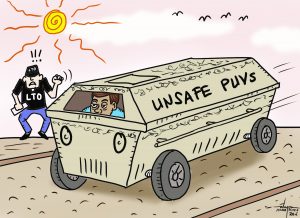When we talk about sustainability, we consider the idea of interconnectedness.
Our actions and lifestyles are inextricably linked with everything else around us. It is not often well pronounced but the effects and impacts of the way we live and make inconspicuous decisions shape the world around us.
Such is the case with fashion. Whether through manufacturers or consumers, fashion remains to be resource intensive and truly a force to be examined in global discussions on climate change, sustainability, and everything else that’s happening in the planet.
I learned about this from a Future Learn online course by the London College of Fashion.
“We’re currently living in an era of global instability, environmentally, politically, economically even. Our population continues to grow, social injustice and human inequality persist, and meanwhile we have already crossed critical planetary boundaries and are close to the edge of others,” says Renée Cuoco, manager at the Centre for Sustainable Fashion, a Research Centre of the University of the Arts London based at London College of Fashion.
“Whilst the fashion industry isn’t solely responsible for this, as one of the world’s biggest and most impactful industries, it has a pretty critical and challenging role to play in safeguarding the future for generations to come,” she says.
Being interested in cross-discipline collaboration and the role of arts and design in the facilitation of social and ecological resilience, Cuoco shares eight important issues that relate fashion to sustainability. This helps us understand the impact of fashion without having to put on a fashion designer or a scientist’s hat.
Cuoco writes: “There are a lot of sustainability problems related to the industrial and personal activities of fashion across its entire global supply chain (they have environmental, social, cultural and economic impacts), quite often these issues affect one another or are connected in some way.”
Climate change: The current level of carbon dioxide in our atmosphere already exceeds what is considered by scientists to be a safe. However, fashion emissions—from production, manufacturing, and everyday use—are still predicted to increase by more than 60 percent over the next 12 years.
In 2016 the Paris Climate Agreement came into force, and this states that a global temperature rise above pre-industrial levels will be kept below two degrees, with a further aim of limiting this increase to 1.5 degrees. So far, 168 countries have officially joined the accord – which means each of these countries is required to make their best efforts to reduce emissions on a national level.
And if we don’t make these changes immediately, the impact of climate change will mean more frequent extreme weather events, and more people displaced by these events.
Water stress: More than a billion people currently lack access to clean water. Yet, fashion is very thirsty—for example, it takes 2700 liters of water to make one cotton t-shirt. That’s enough supply for a person to drink for three years.
Hazardous chemicals and pollution: The fashion industry is one of the largest users of chemicals and in turn is responsible for high levels of water and air pollution, which is hazardous to our ecosystems and human health.
Land use and biodiversity: Fashion is directly linked to habitat loss and a decline in biodiversity through land use. Areas of forested land around the world, for example, have been cleared for cotton cultivation.
Diminishing resources: Fashion relies on natural and human resources. It is dependent on fossil fuels, and it puts hand-based skills and crafts from around the world at risk due to increase in faster and cheaper manufacturing options.
Consumption and waste: Globally the vast majority of discarded clothing ends up in landfills or is incinerated, currently only 20 percent is collected for reuse or recycling.
Modern day slavery: forced labour, trafficking, and exploitation are just some of the ways this persists in the fashion supply chain, which lacks transparency.
Wellbeing: The pace of fashion compromises the wellbeing of workers, communities, wearers, animals and the environment. Workers are exposed to health and safety concerns – from injury, factories fires and disasters, long hours and exposure to hazardous chemicals. Most workers in fashion are not paid decent wages.
“Fashion is a giant industrial activity but it is also part of our day-to-day lives and so it has the power to impact wellbeing in many forms and at many scales,” Cuoco says.
She adds that there is a lot to consider in understanding the relationship between fashion, wellbeing, and sustainability more broadly—and this relationship is not static.
As consumers, we all have roles to play, questions to ask, and actions to reflect upon. Fashion has everything to do with us.
(Let’s talk. Buzz me in social media @jesiramoun)


